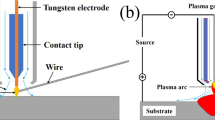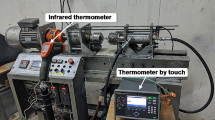Abstract
Due to the hidden joint structure, good joining strength, and simple die structure, double-sided self-pierce riveting (DSSPR) has been seen as a potential alternative to self-pierce riveting or resistance spot welding. The chamfered angle position, a new design parameter of tubular rivets, has been proved to influence the joining strength significantly. However, the corresponding mechanism is still unclear. In this paper, the DSSPR experiments of Al 5052 aluminum alloy sheets using tubular rivets with five chamfered angle positions were carried out. The finite element analysis was adopted to clarify the influence mechanism of the chamfered angle position on the joining strength. Mechanical properties and energy absorption were investigated through single-lap shear tests and cross-tension joint pull-out tests. The deformation behavior of sheets and rivet during the DSSPR process were investigated systematically using finite element simulation. The results showed that chamfered angle position has a significant effect on the section structure and mechanical performance of the joint. The shear strength of l = 0.25 and the pull-out strength of l = 0 were about 125% and 221% higher than that of l = 0.5, respectively. In addition, the counter force F1 influences the rivet expansion direction, and the forces F2 and F3 mainly affect the rivet bending degree. The finite element simulation can effectively predict the material flow, stress, and strain distribution of the rivet and sheets during the DSSPR process. When l = 0 or 0.25, the sheet material flows to the outside of the rivet, and a vortex-like phenomenon is formed at the chamfered position. The influence mechanism of the chamfered angle position on the DSSPR process is discussed and explained. The results can provide a deep understanding of the DSSPR process and help to accelerate its engineering application.


















Similar content being viewed by others
Data availability
Not applicable.
Code availability
Not applicable.
References
Jiang H, Cong Y, Zhang J, Wu X, Li G, Cui JJ (2019) Fatigue response of electromagnetic riveted joints with different rivet dies subjected to pull-out loading. Int J Fatigue 129(12):105238
Chen C, Zhao SD, Cui MC, Han XL, Zhao XZ, Ishida T, Cui MC (2017) Effects of geometrical parameters on the strength and energy absorption of the height-reduced joint. Int J Adv Manuf Technol 90:3533–3541
Mori K, Abe Y, Kato T (2012) Mechanism of superiority of fatigue strength for aluminium alloy sheets joined by mechanical clinching and self-pierce riveting. J Mater Process Technol 212(9):1900–1905
Groche P, Wohletz S, Brenneis M, Pabst C, Resch F (2014) Joining by forming-A review on joint mechanisms, applications and future trends. J Mater Process Technol 214(10):1972–1994
Kumar NA, Vengatesh PT, Karthikeyan K, Tiwari V, Satheeshkumar V (2022) Investigation on the influence of riveting of adhesive bonded steel sheets on springback and delamination. Mater Today 62(14):7635–7641
Jiang H, Zeng C, Li G, Cui J (2020) Effect of locking mode on mechanical properties and failure behavior of CFRP/Al electromagnetic riveted joint. Compos Struct 257:113162
Huang ZC, Liu XK, Xia LJ, Zhan JQ (2012) Joining Strength Comparison among Self-piercing Riveting, Clinching and Resistance Spot Welding. China Mech Eng 20:2487–2491
Kato K, Okamoto M, Yasuhara T (2001) Method of joining sheets by using new type rivets. J Mater Process Technol 111(1):198–203
Alves LM, Afonso RM, Martins PAF (2020) Double-sided self-pierce riveting. Int J Adv Manuf Technol 108(5–6):1541–1549
Alves LM, Afonso RM, Pereira PT, Martins PAF (2021) Double-sided self-pierce riveting of dissimilar materials. Int J Adv Manuf Technol 115:3679–3687
Alves LM, Afonso RM, Pereira PT, Martins PAF (2022) Double-sided self-pierce riveting with flat-bottom holes: a feasibility study. Prod Eng-Res Dev 16(2):401–409
Huang ZC, Xue SG, Liu WY, Chen WD (2014) Effect of radial rate on elliptic pipe self-piercing riveting performance. J Plast Eng 2:129–135
Alves LM, Afonso RM, Martins PAF (2021) Double-sided self-pierce riveting of polymer sheets. J Adv Join Process 3:100051
Alves LM, Moghadam M, Afonso RM, Nielsen CV, Martins PAF (2022) On the applicability limits of double-sided self-pierce riveting. P I Mech Eng L-J Mat 1464–4207
Wang PY, Jin JG, Wan GH, Zhang CS, Zhao XK, Zhao XN et al (2022) Revisiting the design of the rivet chamfered ends in double-sided self-pierce riveting. Thin Wall Struct 176:109375
Funding
This research is supported by the Scientific Research Program Funded by Education Department of Shaanxi Provincial Government (Program No. 22JP010), the Natural Science Basic Research Program of Shaanxi (Program No.2023-JC-YB-379), the National Natural Science Foundation of China (No.51805309, No.52275329), and The Youth Innovation Team of Shaanxi Universities.
Author information
Authors and Affiliations
Corresponding author
Ethics declarations
Conflict of interest
The authors declare no competing interests.
Additional information
Publisher's note
Springer Nature remains neutral with regard to jurisdictional claims in published maps and institutional affiliations.
Rights and permissions
Springer Nature or its licensor (e.g. a society or other partner) holds exclusive rights to this article under a publishing agreement with the author(s) or other rightsholder(s); author self-archiving of the accepted manuscript version of this article is solely governed by the terms of such publishing agreement and applicable law.
About this article
Cite this article
Wang, P., Jin, J., Wang, Y. et al. Double-sided self-pierce riveting: analysis of the mechanisms behind the chamfered angle position. Int J Adv Manuf Technol 126, 325–337 (2023). https://doi.org/10.1007/s00170-023-11127-4
Received:
Accepted:
Published:
Issue Date:
DOI: https://doi.org/10.1007/s00170-023-11127-4




